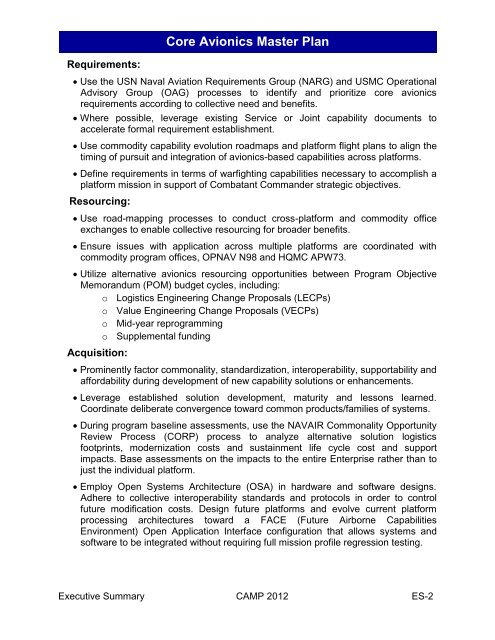PMA209 2012 Core Avionics Master Plan - NAVAIR - U.S. Navy
PMA209 2012 Core Avionics Master Plan - NAVAIR - U.S. Navy
PMA209 2012 Core Avionics Master Plan - NAVAIR - U.S. Navy
You also want an ePaper? Increase the reach of your titles
YUMPU automatically turns print PDFs into web optimized ePapers that Google loves.
<strong>Core</strong> <strong>Avionics</strong> <strong>Master</strong> <strong>Plan</strong>Requirements: Use the USN Naval Aviation Requirements Group (NARG) and USMC OperationalAdvisory Group (OAG) processes to identify and prioritize core avionicsrequirements according to collective need and benefits. Where possible, leverage existing Service or Joint capability documents toaccelerate formal requirement establishment. Use commodity capability evolution roadmaps and platform flight plans to align thetiming of pursuit and integration of avionics-based capabilities across platforms. Define requirements in terms of warfighting capabilities necessary to accomplish aplatform mission in support of Combatant Commander strategic objectives.Resourcing: Use road-mapping processes to conduct cross-platform and commodity officeexchanges to enable collective resourcing for broader benefits. Ensure issues with application across multiple platforms are coordinated withcommodity program offices, OPNAV N98 and HQMC APW73. Utilize alternative avionics resourcing opportunities between Program ObjectiveMemorandum (POM) budget cycles, including:o Logistics Engineering Change Proposals (LECPs)o Value Engineering Change Proposals (VECPs)o Mid-year reprogrammingo Supplemental fundingAcquisition: Prominently factor commonality, standardization, interoperability, supportability andaffordability during development of new capability solutions or enhancements. Leverage established solution development, maturity and lessons learned.Coordinate deliberate convergence toward common products/families of systems. During program baseline assessments, use the <strong>NAVAIR</strong> Commonality OpportunityReview Process (CORP) process to analyze alternative solution logisticsfootprints, modernization costs and sustainment life cycle cost and supportimpacts. Base assessments on the impacts to the entire Enterprise rather than tojust the individual platform. Employ Open Systems Architecture (OSA) in hardware and software designs.Adhere to collective interoperability standards and protocols in order to controlfuture modification costs. Design future platforms and evolve current platformprocessing architectures toward a FACE (Future Airborne CapabilitiesEnvironment) Open Application Interface configuration that allows systems andsoftware to be integrated without requiring full mission profile regression testing.Executive Summary CAMP <strong>2012</strong> ES-2

















